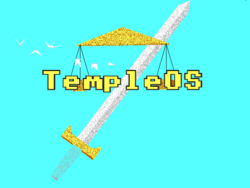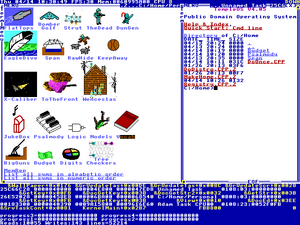Software:TempleOS
 | |
 TempleOS 4.05 | |
| Developer | Terry A. Davis |
|---|---|
| Written in | HolyC |
| Working state | Discontinued |
| Source model | Open source |
| Initial release | 2013 |
| |Final release|Latest release}} | 5.03 / 20 November 2017 |
| Platforms | x86 64 |
| Kernel type | Monolithic |
| Default user interface | Text-based |
| License | Public domain |
TempleOS (formerly J Operating System, SparrowOS and LoseThos) is a biblical-themed lightweight operating system designed to be the Third Temple prophesied in the Bible. It was created by American programmer Terry A. Davis, who developed it alone over the course of a decade after suffering a series of psychotic episodes that he later described as a revelation from God. The OS was released in 2013 and last updated in 2017.
TempleOS was characterized by Davis as a modern x86-64 Commodore 64. He proclaimed that he was in direct communication with God, and that God ordered the OS to have a 640x480 resolution, 16 color display, and a single audio voice.[1] It was programmed with an original variation of C (named HolyC) in place of BASIC and uses an interface similar to a mixture of DOS and Turbo C. It also included an original flight simulator, compiler, and kernel.
Davis struggled with schizophrenia and periods of homelessness throughout his adult life. Over the years, he posted hours of video blogs to social media, and by the time of his death, had amassed a small online following. One fan described him as a "programming legend", while another, a computer engineer, compared the development of TempleOS to a one-man-built skyscraper.[2] Davis was killed in a train accident on August 11, 2018 at the age of 48.[2]
Background
Terrence Andrew Davis (December 15, 1969 – August 11, 2018) was born in West Allis, Wisconsin, later moving to Washington, Michigan, California, and Arizona. He was the seventh of eight children and his father was an industrial engineer. As a child, Davis owned an Apple II, and subsequently learned assembly language on a Commodore 64. He earned a masters degree in electric engineering from Arizona State University and worked for several years at TicketMaster[1] as a programmer for the company's VAX operating system.[3] In 1996, Davis began experiencing regular manic episodes, leading him to numerous stays at mental hospitals. Initially diagnosed with bipolar disorder, he was later declared schizophrenic and remained unemployed for the rest of his life.[1]
Davis worked on TempleOS for 12 years.[4] Its development began circa 2003,[1] after he suffered from delusions of space aliens and government agents that left him briefly hospitalized for his mental health issues.[1][5] Davis grew up Catholic and was an atheist before experiencing a self-described "revelation". He described the experience as seeming "a lot like mental illness ... I felt guilty for being such a technology-advocate atheist ... It would sound polite if you said I scared myself thinking about quantum computers."[1] Afterward, he proclaimed that he was in direct communication with God, that God told him the operating system he built was for God's third temple, and that TempleOS is of "divine intellect" due to the inspired nature of the code. He initially called it the "J Operating system" and later renamed it to "LoseThos", a reference to a scene from Platoon (1986).[1] Another name he used was "SparrowOS" before settling on "TempleOS".[3]
System overview
TempleOS is a 64 bit, non-preemptive multi-tasking,[6] multi-cored, public domain, open source, ring-0-only, single address space, non-networked, PC operating system for recreational programming.[7] The OS runs 8-bit ASCII with graphics in source code and has a 2D and 3D graphics library, which run at 640x480 VGA with 16 colors.[3] Like most modern operating systems, it has keyboard and mouse support. It supports ISO 9660, FAT32 and RedSea file systems (the latter created by Davis) with support for file compression.[8] According to Davis, many of these specifications—such as the 640x480 resolution, 16 color display, and single audio voice—were instructed to him by God.[1] It also included an original flight simulator, compiler, and kernel.[4]
The operating system was written in a programming language developed by Davis in C and C++, called "HolyC".[3] HolyC is a variation of C, developed by Davis as the programming language of TempleOS. It is used to interact with the shell, and to write and execute entire applications from the shell. The IDE that comes with TempleOS supports several features, such as embedding images in code. It uses a non-standard text format (known as DolDoc) which has support for hypertext links, images and 3D meshes to be embedded into what are otherwise regular ASCII files. A file can have, for example, a spinning 3D model of a tank as a comment in source code. Code can be JIT-compiled.[9] He ultimately wrote over 100,000 lines of code for the OS.[4]
Death of Davis and legacy
Davis was controversial for his regular use of racist and homophobic slurs,[1][4] sometimes rebuking his critics as "niggers".[1] However, the critical reception to TempleOS was mostly favorable [citation needed], as tech journalist David Cassel wrote, "programming websites tried to find the necessary patience and understanding to accommodate Davis".[4] TechRepublic and OS News published positive articles on Davis' work, even though Davis was banned from the latter for hostile comments targeting its readers and staff.[4] He frequently communicated in randomly-generated blocks of text and off-topic declarations about God, which led to other bans from Something Awful, Reddit, and Hacker News.[1]
Once TempleOS was released, most of Davis' time was spent "coding, web surfing, or using the output from the National Institute of Standards and Technology randomness beacon to talk to God".[1] He posted hours of video blogs to social media,[2] referring to himself as "the smartest programmer that's ever lived",[4] and attracted a small online following.[2][4] One fan described him as a "programming legend", while another, a computer engineer, compared the development of TempleOS to a one-man-built skyscraper.[2] He was "always lucid" talking with fans if the subject was about computers.[4] In 2017, the OS was shown as a part of an outsider art exhibition in Bourogne, France.[10]
During his final years, Davis struggled with periods of homelessness and brief jailtime. He stopped taking medication because he believed it limited his creativity. Some fans helped him by bringing him supplies, but he refused their housing offers.[4] On the evening of August 11, 2018, while walking alongside railroad tracks in The Dalles, Oregon, he was struck from the back and killed by a Union Pacific train. Investigators could not determine if his death was suicide or accidental.[2] In his final video, recorded and uploaded hours before his death, he explained that he had recently removed most of his videos because did not wish to "litter" the Internet. As reports of his death surfaced online, he was memorialized by fans in a number of tributes posted to social media.[4]
References
- ↑ 1.00 1.01 1.02 1.03 1.04 1.05 1.06 1.07 1.08 1.09 1.10 1.11 Hicks, Jesse (November 25, 2014). "God's Lonely Programmer". VICE Motherboard. http://motherboard.vice.com/read/gods-lonely-programmer. Retrieved 2015-04-21.
- ↑ 2.0 2.1 2.2 2.3 2.4 2.5 Cecil, Neita (September 7, 2018). "Man killed by train had tech following". The Dalles Chronicle. http://www.thedalleschronicle.com/news/2018/sep/07/man-killed-train-had-tech-following/. (Subscription content?)
- ↑ 3.0 3.1 3.2 3.3 Sanders, James (January 21, 2014). "TempleOS: an educational tool for programming experiments". TechRepublic. http://www.techrepublic.com/blog/software-engineer/templeos-an-educational-tool-for-programming-experiments/. Retrieved 2015-04-21.
- ↑ 4.00 4.01 4.02 4.03 4.04 4.05 4.06 4.07 4.08 4.09 4.10 Cassel, David (September 23, 2018). "The Troubled Legacy of Terry Davis, 'God's Lonely Programmer'". https://thenewstack.io/the-troubled-legacy-of-terry-davis-gods-lonely-programmer/.
- ↑ Bruet-Ferréol, Quentin (May 13, 2014). "Temple OS, un système d'exploitation pour parler à Dieu codé par un fou génial" (in fr). Slate.fr. http://www.slate.fr/story/86549/temple-os-systeme-exploitation-parler-dieu. Retrieved 2015-04-21.
- ↑ Davis, Terry A. (n.d.). "Scheduler". Archived from the original on 2016-06-01. https://web.archive.org/web/20160601003411/http://www.templeos.org/Wb/Kernel/Sched.html. Retrieved 2018-06-16.
- ↑ Mathieu, Bruno (November 28, 2014). "TempleOS : le système d'exploitation qui parle à Dieu" (in fr). Tom's Guide. http://www.tomsguide.fr/actualite/templeos-systeme-exploitation-parler-dieu,45703.html. Retrieved 2015-04-21.
- ↑ Davis, Terry A. (n.d.). "The Temple Operating System". Archived from the original on 2017-03-31. https://web.archive.org/web/20170331120502/http://www.templeos.org/Wb/Doc/Features.html#l1.
- ↑ Mitton, Richard (June 8, 2015). "A Constructive Look At TempleOS". http://www.codersnotes.com/notes/a-constructive-look-at-templeos/.
- ↑ Godin, Philippe (2017-01-13). "la Diagonale de l’art - ART BRUT 2.0" (in fr). http://diagonaledelart.blogs.liberation.fr/2017/01/13/art-brut-20/.
External links
- TempleOS Website
- Archive of the TempleOS website and operating system
- Archive of the TempleOS bootable ISO images
 |


